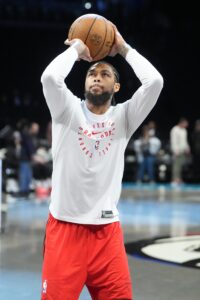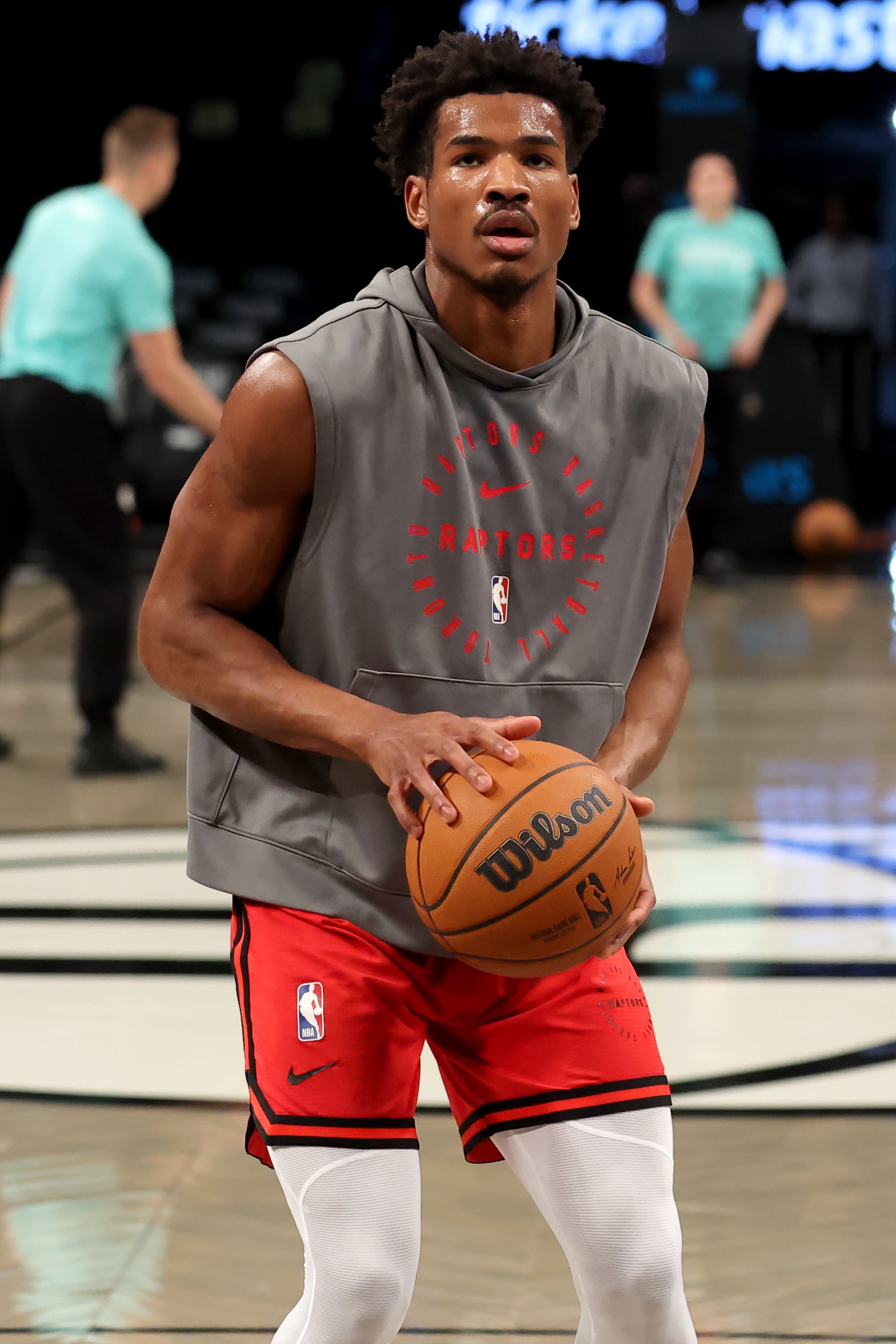Hoops Rumors is checking in on the 2025 offseason for all 30 NBA teams, recapping the summer’s free agent signings, trades, draft picks, departures, and more. We’ll take a look at each team’s offseason moves and consider what might still be coming before the regular season begins. Today, we’re focusing on the Toronto Raptors.
Free agent signings
 Sandro Mamukelashvili: Two years, minimum salary. Second-year player option. Signed using minimum salary exception.
Sandro Mamukelashvili: Two years, minimum salary. Second-year player option. Signed using minimum salary exception.- Garrett Temple: One year, minimum salary. Re-signed using minimum salary exception. Waived right to veto trade.
- David Roddy: One year, minimum salary. Non-guaranteed (Exhibit 10). Signed using minimum salary exception.
- Olivier Sarr: One year, minimum salary. Non-guaranteed (Exhibit 10). Signed using minimum salary exception.
Trades
- None
Draft picks
- 1-9: Collin Murray-Boyles
- Signed to rookie scale contract (four years, $28,822,764).
- 2-39: Alijah Martin
- Signed to two-way contract.
Two-way signings
- Chucky Hepburn
- One year, $85,300 partial guarantee.
- Alijah Martin
- One year, $85,300 partial guarantee (will increase to $318,218 at start of regular season).
Note: The Raptors carried over Ulrich Chomche on a two-way contract from 2024/25.
Departed/unsigned free agents
- Chris Boucher (Celtics)
Other roster moves
- Signed Jakob Poeltl to a three-year, $84,084,000 contract extension that begins in 2027/28. Exercised ’26/27 player option ($19.5MM base salary; $500K in incentives) as part of agreement. Third year is partially guaranteed for $5MM (partial guarantee can increased based on performance criteria). Includes trade kicker (5%).
- Waived Colin Castleton (non-guaranteed contract).
- Waived Jared Rhoden (two-way contract).
Salary cap situation
- Operating over the cap ($154.6MM) and above the luxury tax line ($187.9MM).
- Carrying approximately $190.7MM in salary ($188.4MM guaranteed).
- No hard cap.
- Taxpayer mid-level exception ($5,685,000) available.
The offseason so far
When we talk about a team getting a head-start on the summer by making its big offseason moves at the trade deadline, the 2025 Raptors are exactly what we’re talking about.
 Toronto was well on its way to a lottery finish in 2024/25 when the front office swung a deal to acquire Pelicans forward Brandon Ingram, a former All-Star who had been sidelined since December due to an ankle injury and ultimately ended up missing the rest of the season.
Toronto was well on its way to a lottery finish in 2024/25 when the front office swung a deal to acquire Pelicans forward Brandon Ingram, a former All-Star who had been sidelined since December due to an ankle injury and ultimately ended up missing the rest of the season.
Shortly after giving up two players and a pair of draft picks (including a lightly protected first-rounder) to acquire him, the Raptors signed Ingram to a three-year, $120MM contract extension to ensure he didn’t reach unrestricted free agency this summer.
The Ingram trade and extension were clearly completed with an eye toward the 2025/26 season (and beyond), and the fact that the Raptors made them well ahead of the offseason meant that it ended up being a fairly quiet summer in Toronto, at least in terms of roster changes.
The Raptors are one of just three teams that hasn’t made a single trade since the regular season ended. They also haven’t added a free agent on a contract worth more than the minimum — outside of re-signing veteran locker room leader Garrett Temple, their only real foray into free agency was adding big man Sandro Mamukelashvili to a two-year, minimum-salary deal to add more depth to the frontcourt as longest-tenured Raptor Chris Boucher departed Toronto.
The Raptors did have a lottery pick at No. 9 overall, which they used to select Collin Murray-Boyles out of South Carolina. The belief in some corners was that the team should have used that pick on Duke center Khaman Maluach, who unexpectedly slipped out of the top eight. But Toronto is clearly high on Murray-Boyles, who has drawn Draymond Green comparisons and had a solid Summer League debut last month, with averages of 10.5 points, 5.5 rebounds, 2.0 assists, and 1.8 steals per game on 57.1% shooting.
Expecting Murray-Boyles to make an immediate impact this fall may not be realistic, but the 20-year-old is an intriguing young building block for Toronto. And while it will be tempting to compare his progress in the coming years to Maluach’s, the Raptors made it clear by extending Jakob Poeltl through 2029/30 that they view their starting center of the present as their center of the future too, at least for the next few seasons.
The $28MM-per-year price tag on the three seasons newly added to Poeltl’s contract may be a little higher than some fans expected, but the third year isn’t fully guaranteed, and the big man picked up his more team-friendly $19.5MM option for 2026/27 as part of the agreement. Plus, the stark contrast between the Raptors’ metrics when Poeltl is on and off the court over the past couple seasons suggests he’s one of the league’s more underrated big men.
While drafting Murray-Boyles and extending Poeltl were important moves that will impact the club for years to come, the dismissal of longtime team president Masai Ujiri may have been the most consequential long-term decision made by the Raptors this summer.
Ujiri, who took over as Toronto’s head of basketball operations in 2013, built the first championship roster in franchise history (2018/19) and helped shape the organization’s culture during his decade-plus with the team. Given his reputation and the timing of the move (a day after the draft), the news of his ouster came as a bit of a surprise, but Ujiri had also made his share of questionable roster decisions in recent years and didn’t see eye-to-eye with the new ownership group.
The Raptors continue to search for a full-time replacement for Ujiri, with general manager Bobby Webster – who is currently running basketball operations – viewed as a candidate for the role.
Up next
Hiring a permanent president of basketball operations may be the top remaining item on Toronto’s offseason to-do list, but it’s not the only task on the agenda.
 Perhaps most pressingly, the Raptors are currently operating over the luxury tax line, which presumably isn’t the end goal for a team coming off a 30-win season. They also find themselves above the first tax apron due to the incentives in the Immanuel Quickley, RJ Barrett, and Poeltl contracts.
Perhaps most pressingly, the Raptors are currently operating over the luxury tax line, which presumably isn’t the end goal for a team coming off a 30-win season. They also find themselves above the first tax apron due to the incentives in the Immanuel Quickley, RJ Barrett, and Poeltl contracts.
Getting under the first apron would be straightforward enough. Waiving A.J. Lawson‘s non-guaranteed contract and beginning the season with 14 players on the standard roster would do the trick. That would afford the Raptors all the flexibility of a non-apron team, including being able to take back more salary than they send out in a trade (albeit with little breathing room under the apron to actually do so).
But getting out of tax territory is probably the more important consideration, and cutting Lawson wouldn’t quite get them there — the Raptors would still be in the tax by about $800K in that scenario.
That amount is so modest that it wouldn’t be hard for the club to address the issue with a minor trade during the season, so it doesn’t necessarily have to be done by opening night. In fact, it could make more sense to wait until the Raptors have a better sense of how Ingram fits together with the rest of the roster. While moving off a minimum-salary player at the trade deadline would get Toronto out of the tax, the team may be inclined to make a more significant deal involving a higher-paid player in which one of the goals would be to take back a little less salary than is sent out.
It’s also worth keeping an eye on former lottery pick Ochai Agbaji in the next couple months. The fourth-year wing has shown some promise, but it’s unclear whether he’s still part of the long-term plans in Toronto as he enters the final season of his rookie contract. He’s extension-eligible until October 20, and if he doesn’t sign a new deal by that time, his expiring $6.4MM deal could make him a trade candidate.
Why is this lowkey a good team? I think they will make the playoffs, maybe top 6 seed
In this conference this year, it’s entirely possible. I see only NYK, CLE, ORL, DET, and ATL clearly ahead of them.
@Bargzzz, that’s my top 6 also, assuming Porzingis can stay healthy.
But if Porzingis is only good 50 games (like the last 5 years suggest), ATL drops down a tier, and TOR moves up.
Appreciate the Zingus zinger!
They’re better than Detroit
Brabo,
I agree, and see them as a dark horse for a deep playoff run. Injuries held them back last year, but they have a bunch of emerging young talent (Barnes, Quickley, Dick, and Barrett), and a enough defense to hide Ingram, who I expect to get back to 24 ppg.
I disagree. This team is in bad shape. Two moves away. This team is full of Small Forwards. Hopefully they can make it to the playoffs but I doubt it
Toronto Small Forwards
Letting Chris Boucher go was a braindead move. The only guy left from your only championship…. That’s a player that retires on your team. Raptors did Chris dirt. Also did Rhoden dirty
Raptors success this year hinges on a few key things… gotta stay relatively healthy…. CMB has to be a good bench contributor…. Dick has to show more… and most importantly Barnes gotta improve his 3 pt game. Prediction… within a game or two of 41-41 year
Have fun G Temple babysitting the whole roster of 20 year old’s that are all average players
Raptors are gonna be a top5 team in the east this year book it. They’re 2 deep at every position and everyone gets to move down a peg on the pecking order with Ingram here now. They were purposely tanking & still won 30 games last year. Their wings are gonna have a size advantage on most nights